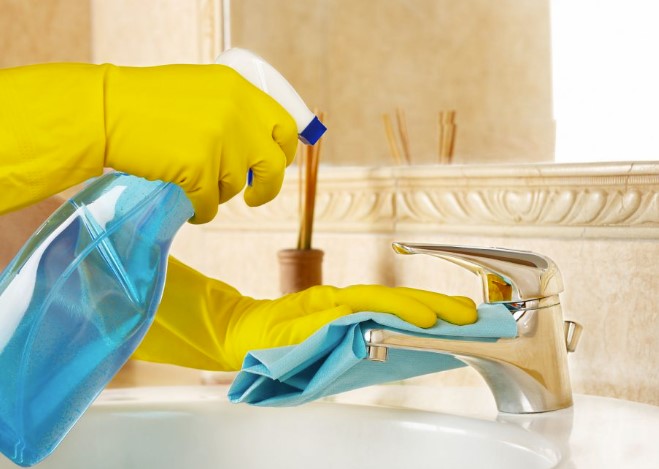Maintaining a clean and germ-free home is crucial for the health and well-being of you and your family, especially in a world where infectious diseases can easily spread. Proper disinfection plays a key role in preventing the transmission of viruses, bacteria, and other harmful microorganisms.
In this comprehensive guide, we will explore effective strategies and techniques on how to properly disinfect your home to create a safe and healthy living environment.
Understand the difference between cleaning and disinfecting
Before delving into the specifics of disinfection, it’s essential to understand the distinction between cleaning and disinfecting. Cleaning involves removing dirt, dust, and debris from surfaces, while disinfecting targets and eliminates harmful microorganisms.
To achieve optimal results, it’s important to both clean and disinfect your home regularly. This two-pronged approach ensures that surfaces are not only visually clean but also free from potential health hazards.
Identify high-touch surfaces
Certain areas in your home are more prone to harboring germs due to frequent contact. These high-touch surfaces include doorknobs, light switches, remote controls, countertops, faucets, and electronic devices.
Prioritize these areas during your cleaning and disinfection routine to minimize the risk of spreading infections. Regularly disinfecting these surfaces is crucial, as they serve as hotspots for the transfer of germs between family members and visitors.
Choose the right disinfectant
Selecting an appropriate disinfectant is crucial for effective germ elimination. The U.S. Environmental Protection Agency (EPA) provides a list of approved disinfectants that have been proven to be effective against various pathogens.
Ensure that the product you choose is suitable for the surfaces you intend to disinfect and follow the manufacturer’s instructions for proper usage. Remember that not all disinfectants are created equal, and some may be more effective against specific types of microorganisms.
Clean before disinfecting
As mentioned earlier, cleaning and disinfecting go hand in hand. Cleaning surfaces before disinfecting removes dirt and grime, allowing the disinfectant to work more effectively. Use a mild detergent and warm water to clean surfaces thoroughly before applying the disinfectant. This initial cleaning step not only improves the efficacy of the disinfectant but also contributes to the overall cleanliness of your home.
As you embark on the cleaning process, be attentive to hidden or easily overlooked areas, such as corners, crevices, and frequently touched items like light switches, to ensure a comprehensive cleaning routine that sets the stage for effective disinfection.
Follow proper disinfection techniques
To properly disinfect surfaces, it’s important to follow these steps:
a. Wear disposable gloves to protect your hands.
b. Apply the disinfectant to the surface and let it sit for the recommended contact time.
c. Ensure that the surface remains wet during the entire contact time.
d. Allow the surface to air dry or wipe it down with a clean cloth.
Remember to pay special attention to frequently touched surfaces, such as light switches and doorknobs. Following these proper disinfection techniques is essential for maximizing the effectiveness of the disinfectant and reducing the risk of microbial contamination.
Disinfect soft surfaces
In addition to hard surfaces, don’t forget about soft surfaces like upholstery, carpets, and curtains. Use appropriate disinfectant products designed for these surfaces or consider using a fabric-safe disinfectant spray. Regularly launder and vacuum soft surfaces to further reduce the risk of contamination.
Soft surfaces can harbor microorganisms, so incorporating disinfection into your routine for these items is crucial for maintaining a thorough and comprehensive cleaning regimen. Another great idea would be to hire a professional cleaning company. Experts at Crystal Maids could ensure that any house is flawlessly clean and disinfected.
Practice proper hand hygiene
One of the most effective ways to prevent the spread of germs is by, of course, practicing good hand hygiene. Make sure to use water and soap frequently to wash your hands (for at least 20 seconds), especially after cleaning and disinfecting your home.
If soap and water are not available, use an alcohol-based hand sanitizer. That is because hand hygiene is a fundamental aspect of maintaining a clean and safe living environment, and it complements the disinfection efforts undertaken throughout your home.
Ventilate your home
Ventilate your home by opening windows and doors when possible to allow fresh air to circulate through your living spaces. Proper ventilation is essential to maintain indoor air quality. Good ventilation helps disperse airborne particles and reduces the concentration of indoor pollutants.
Adequate ventilation is particularly important during and after disinfection activities, as it helps to dissipate any fumes or residues from cleaning products. Consider using air purifiers to further enhance the air quality in enclosed spaces, ensuring a comprehensive approach to creating a clean and breathable atmosphere in your home.
Establish a regular cleaning schedule
Establish a regular cleaning schedule by developing a plan that includes daily, weekly, and monthly tasks. Consistency is key in maintaining a clean and disinfected home, ensuring that no areas are neglected over time.
Regular cleaning and disinfection contribute to a healthier living environment for you and your family, fostering a sense of well-being and comfort in your home. A structured cleaning schedule becomes a cornerstone of your home maintenance routine, providing a systematic and effective approach to uphold cleanliness standards consistently.
Stay informed and adapt
Stay informed about the latest guidelines and recommendations from health authorities and adjust your cleaning practices accordingly. Emerging infectious diseases may require additional precautions, so staying up-to-date on the latest information is essential.
Regularly check reliable sources for updates on effective disinfection practices and incorporate any new recommendations into your routine. Remaining informed and adaptable is key to maintaining a proactive and effective approach to home disinfection.
Conclusion
Properly disinfecting your home is a crucial step in safeguarding the health of your family and preventing the spread of infectious diseases. By understanding the difference between cleaning and disinfecting, identifying high-touch surfaces, choosing the right disinfectant, and following proper techniques, you can create a safe and healthy living environment.
Incorporate these practices into your regular cleaning routine to promote overall well-being and peace of mind, ensuring that your home remains a haven for health and happiness.



